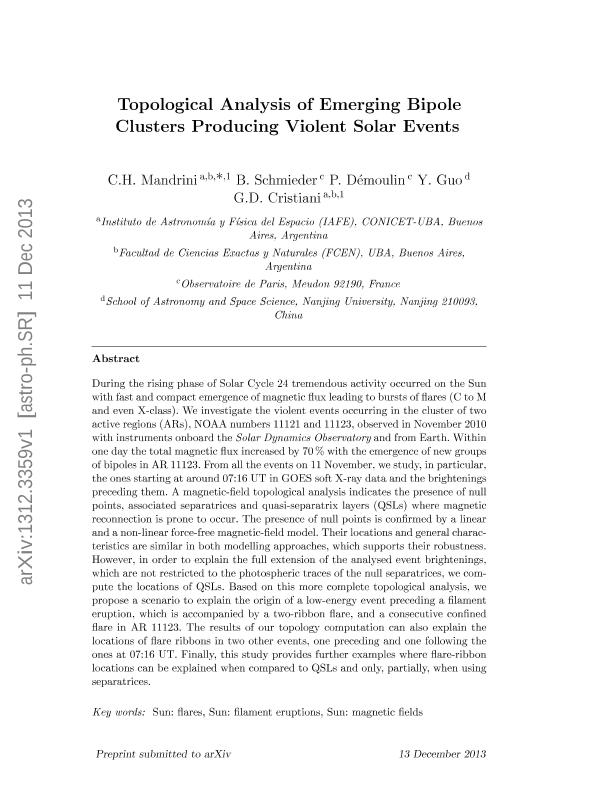Mostrar el registro sencillo del ítem
dc.contributor.author
Mandrini, Cristina Hemilse

dc.contributor.author
Schmieder, B.
dc.contributor.author
Démoulin, Pascal

dc.contributor.author
Guo, Y.
dc.contributor.author
Cristiani, Germán Diego

dc.date.available
2017-06-06T15:16:09Z
dc.date.issued
2014-06
dc.identifier.citation
Mandrini, Cristina Hemilse; Schmieder, B.; Démoulin, Pascal; Guo, Y.; Cristiani, Germán Diego; Topological Analysis of Emerging Bipole Clusters Producing Violent Solar Events; Springer; Solar Physics; 289; 6; 6-2014; 2041-2071
dc.identifier.issn
0038-0938
dc.identifier.uri
http://hdl.handle.net/11336/17564
dc.description.abstract
During the rising phase of Solar Cycle 24 tremendous activity occurred on the Sun with fast and compact emergence of magnetic flux leading to bursts of flares (C to M and even X-class). We investigate the violent events occurring in the cluster of two active regions (ARs), NOAA numbers 11121 and 11123, observed in November 2010 with instruments onboard the Solar Dynamics Observatory and from Earth. Within one day the total magnetic flux increased by 70% with the emergence of new groups of bipoles in AR 11123. From all the events on 11 November, we study, in particular, the ones starting at around 07:16 UT in GOES soft X-ray data and the brightening preceding them. A magnetic-field topological analysis indicates the presence of null points, associated separatrices, and quasi-separatrix layers (QSLs) where magnetic reconnection is prone to occur. The presence of null points is confirmed by a linear and a non-linear force-free magnetic-field model. Their locations and general characteristics are similar in both modelling approaches, which supports their robustness. However, in order to explain the full extension of the analysed event brightenings, which are not restricted to the photospheric traces of the null separatrices, we compute the locations of QSLs. Based on this more complete topological analysis, we propose a scenario to explain the origin of a low-energy event preceding a filament eruption, which is accompanied by a two-ribbon flare, and a consecutive confined flare in AR 11123. The results of our topology computation can also explain the locations of flare ribbons in two other events, one preceding and one following the ones at 07:16 UT. Finally, this study provides further examples where flare-ribbon locations can be explained when compared to QSLs and only, partially, when using separatrices.
dc.format
application/pdf
dc.language.iso
eng
dc.publisher
Springer

dc.rights
info:eu-repo/semantics/openAccess
dc.rights.uri
https://creativecommons.org/licenses/by-nc-sa/2.5/ar/
dc.subject
Sun: Flares
dc.subject
Sun: Filament Eruptions
dc.subject
Sun: Magnetic Fields
dc.subject.classification
Astronomía

dc.subject.classification
Ciencias Físicas

dc.subject.classification
CIENCIAS NATURALES Y EXACTAS

dc.title
Topological Analysis of Emerging Bipole Clusters Producing Violent Solar Events
dc.type
info:eu-repo/semantics/article
dc.type
info:ar-repo/semantics/artículo
dc.type
info:eu-repo/semantics/publishedVersion
dc.date.updated
2017-06-01T16:46:10Z
dc.journal.volume
289
dc.journal.number
6
dc.journal.pagination
2041-2071
dc.journal.pais
Alemania

dc.journal.ciudad
Berlin
dc.description.fil
Fil: Mandrini, Cristina Hemilse. Consejo Nacional de Investigaciónes Científicas y Técnicas. Oficina de Coordinación Administrativa Ciudad Universitaria. Instituto de Astronomía y Física del Espacio. - Universidad de Buenos Aires. Facultad de Ciencias Exactas y Naturales. Instituto de Astronomía y Física del Espacio; Argentina
dc.description.fil
Fil: Schmieder, B.. Centre National de la Recherche Scientifique. Observatoire de Paris; Francia
dc.description.fil
Fil: Démoulin, Pascal. Centre National de la Recherche Scientifique. Observatoire de Paris; Francia
dc.description.fil
Fil: Guo, Y.. Nanjing University; China
dc.description.fil
Fil: Cristiani, Germán Diego. Consejo Nacional de Investigaciónes Científicas y Técnicas. Oficina de Coordinación Administrativa Ciudad Universitaria. Instituto de Astronomía y Física del Espacio. - Universidad de Buenos Aires. Facultad de Ciencias Exactas y Naturales. Instituto de Astronomía y Física del Espacio; Argentina
dc.journal.title
Solar Physics

dc.relation.alternativeid
info:eu-repo/semantics/altIdentifier/doi/http://dx.doi.org/10.1007/s11207-013-0458-6
dc.relation.alternativeid
info:eu-repo/semantics/altIdentifier/url/https://arxiv.org/abs/1312.3359
dc.relation.alternativeid
info:eu-repo/semantics/altIdentifier/url/https://link.springer.com/article/10.1007/s11207-013-0458-6
Archivos asociados
